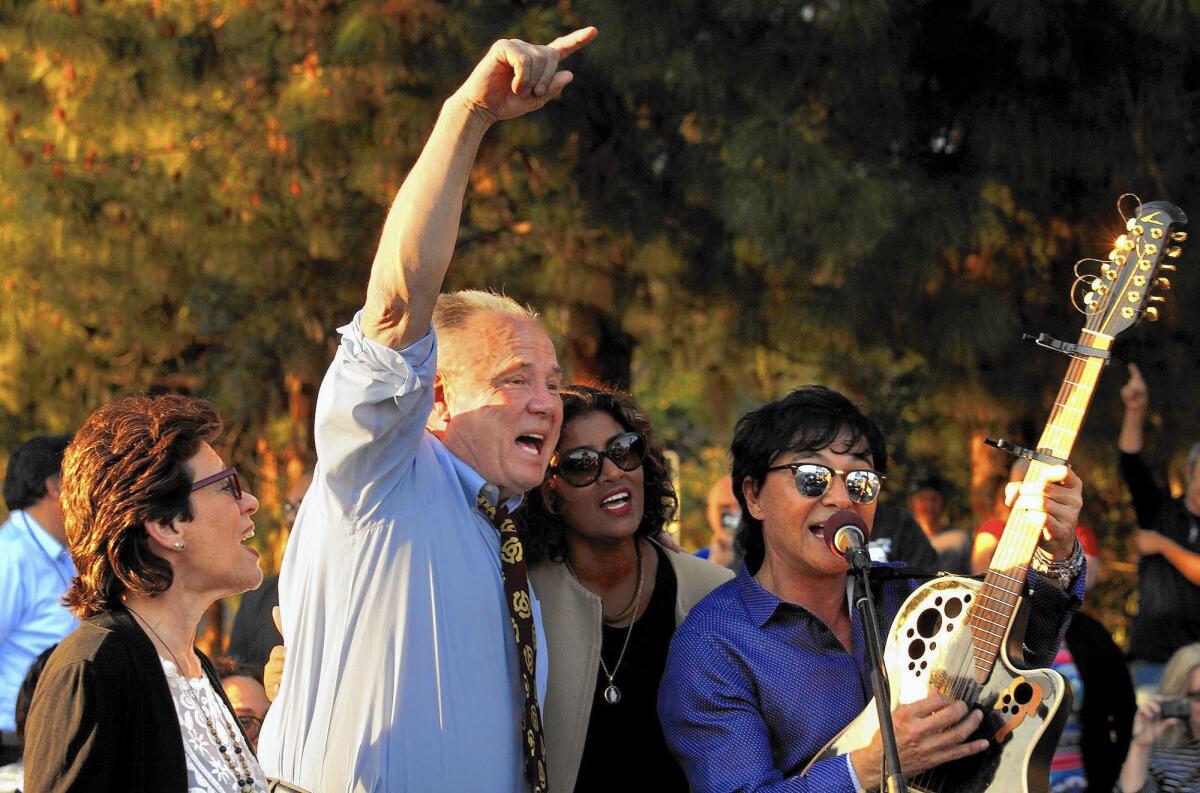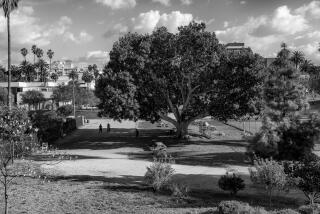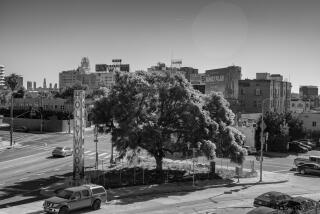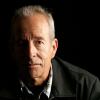Post-beetles, a new tree is planted in George Harrison’s memory

George Harrison was quoting ancient spiritual wisdom when he titled his 1970 solo album “All Things Must Pass,” never suspecting that the proverb would one day apply to the fate of a pine tree planted in his memory in Griffith Park.
But two of Harrison’s family members, a Los Angeles City Council member, a longtime fan and other admirers did their part Wednesday, on what would have been the former Beatle’s 72nd birthday, to right a wrong committed last year when an insect infestation — yes, they were beetles — killed what was known as the George Harrison Tree.
A new tree of a different species — a 10-foot tall shrubby yew pine, chosen by Harrison’s family — replaced the original Canary Island pine tree in a ceremony attended by 200 to 300 people near Griffith Observatory.
When word went out last year that the original tree had been felled by tree beetles, the story made international headlines.
Councilman Tom LaBonge, whose 4th District includes Griffith Park, helped plant the original tree in 2002 not long after Harrison died Nov. 29, 2001, in Los Angeles, from cancer at the age of 58.
“We had a tribute on the steps of the observatory,” recalled LaBonge, now in his final term of office, “and several hundred people wrote notes, which we’ve collected in a book ‘We Remember George.’ ”
Two years later, the City Council proclaimed George Harrison Day in Los Angeles, and the tree was commemorated with a bronze plaque embedded in a granite slab, saluting him as “a great humanitarian who touched the world as an artist, a musician and gardener.”
One of the organizers of the first tree planting, the plaque and the current replanting project, Paula Greenfield, said she thinks he would have mourned the loss of life of the original tree but would have appreciated the irony of the cause.
Harrison once said his biggest break in life was getting into the Beatles, and that his second biggest break was getting out.
“It takes four things to make something grow,” Greenfield said. “Soil, water, sun, love — and here we are. We’ve got it all.”
Griffith Observatory Director Edwin C. Krupp referred to one of Harrison’s best-known songs, “Here Comes the Sun,” and pointed to the facility’s solar telescope, saying, “There’s not a time that dome opens that I don’t think of that song.”
Harrison’s widow, Olivia, and their son, musician Dhani Harrison, were out of town and did not attend, but Harrison’s older sister, Louise, and Olivia’s sister Linda Arias took part in the ceremony. Jack Oliver, former president of the Beatles’ Apple Records label, also was on hand.
“I was very hesitant to even approach Olivia with any of these public tributes that we did,” Greenfield said. “We all know how private George was. But she understands that it’s the public that wants this. We need it, we want it: a public place to think of George. That’s how it all started. He loved nature, and he loved Griffith Park.”
Harrison famously bought a rundown English estate in 1970, just as the Beatles were breaking up, and spent years rejuvenating its extensive but long-neglected gardens. The estate once belonged to an English lord named Sir Frankie Crisp, whom Harrison acknowledged in the title of “The Ballad of Sir Frankie Crisp (Let It Roll,)” one of the songs on “All Things Must Pass.”
Greenfield said the real culprit in the death of the first tree honoring Harrison was California’s drought. “It’s because of the drought that beetles are able to get into the trees to begin with. I’ve had neighbors who’ve lost trees during this drought — when they take them down they’re totally hollowed out.”
The yew tree that’s replacing the original, Greenfield said, is of a species that survived the ice age and is far less susceptible to infestation by insects.
Especially beetles.
More to Read
The biggest entertainment stories
Get our big stories about Hollywood, film, television, music, arts, culture and more right in your inbox as soon as they publish.
You may occasionally receive promotional content from the Los Angeles Times.







